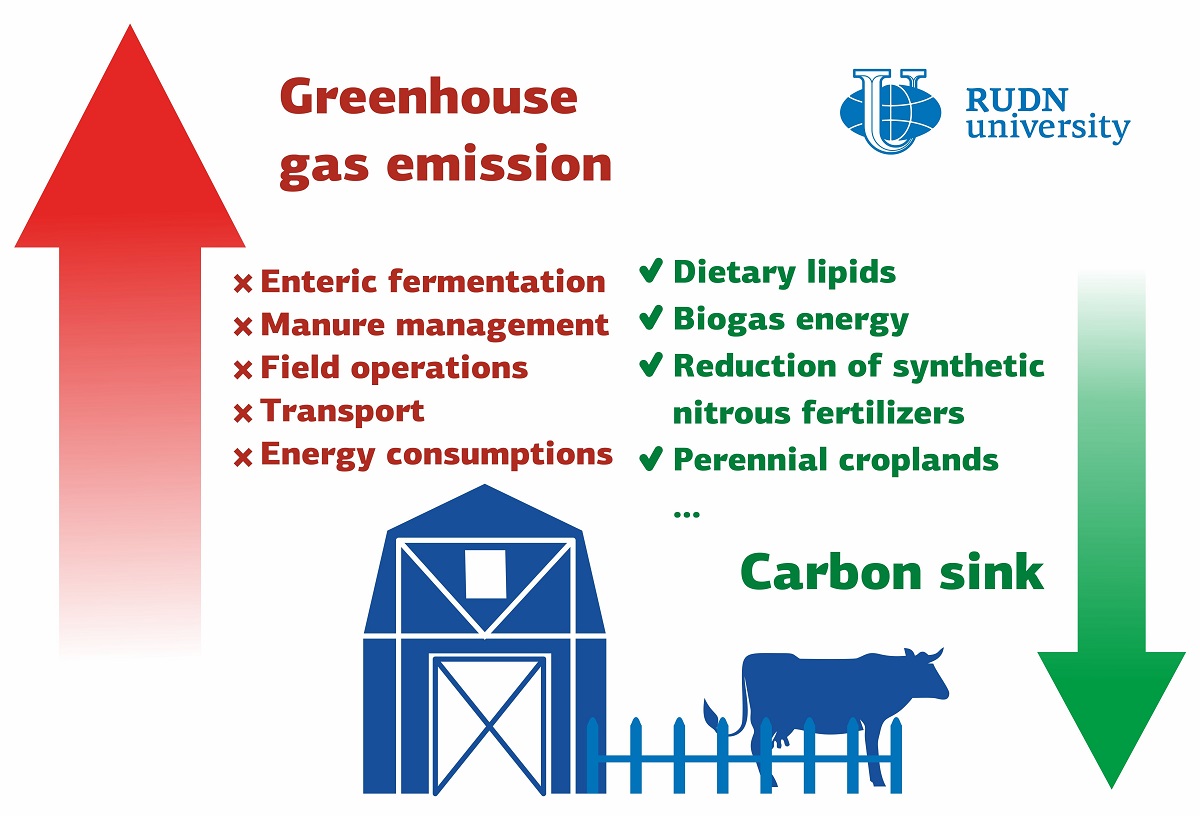RUDN University ecologist suggested a way to reduce greenhouse gas emissions in animal farming

Crop and animal farming and other agricultural activities account for almost a quarter of all greenhouse gases produced by humanity and therefore add a lot to climate change. On the other hand, the soils and biomass accumulate a lot of carbon, thus preventing it from getting into the atmosphere as a part of carbon dioxide and slowing climate change down. An ecologist from RUDN University suggested a comprehensive approach to finding a balance between these two processes and reducing greenhouse gas emissions.
In his study, he focused on animal plants in the agricultural regions of Italy. The suggested approach consists of two steps. The first combines different methods of carbon footprint evaluation at all stages of animal farming. Many factors including the production of methane in the digestive tracts of animals, nitrogen oxide emissions in the course of manure processing, the effect of fertilizers and farm machinery, as well as the extermination of pests are taken into consideration. In step two, measures aimed at reducing the amounts of greenhouse emissions are analyzed. For example, a diet rich in fats reduces the production of methane by cattle, and maintaining a natural grass cover around farms helps retain more carbon in the biomass. Another measure is using renewable energy sources instead of fossil fuels.
The team tested their approach on a 13 ha area in the Lazio region in central Italy. The area has two animal plants with 25% of their territories covered in crop fields and orchards and over 40%--in pastures and feed crops. The team established that both farms produced 3.9 megatons of CO2 equivalent per year. The majority of emissions came from the cattle, as well as sprinkler systems, crops, and the energy supply of the stalls.
Having analyzed all possible measures, the team concluded that the annual volume of emissions of CO2 equivalent could be reduced by 3.9-5 megatons. Therefore, the farms could not only eliminate any greenhouse gas emissions but also consume additional carbon from the atmosphere. The so-called minimum tillage could lead to the biggest effect--1.3 to 2 megatons of consumed CO2 equivalent a year. This method calls for no cultivation of the soil between seeding and harvest and for leaving the remains of harvested crops in the fields to form humus. This way more carbon is accumulated in the soils.
"We have confirmed that some animal farms can become carbon neutral and eliminate their greenhouse gas emissions. However, to achieve this, they have to implement all the recommended measures at the same time, and such a considerable change could be associated with many difficulties. Therefore, although our method is applicable on a smaller scale and aimed at individual farms, it requires support from governmental and economic institutions," said Riccardo Valentini, a Ph.D. in Biology, the head of the Science and Research Laboratory "Smart Technologies for Sustainable Development of the Urban Environment in the Global Change" at RUDN University, and a Nobel Prize winner as a member of the Intergovernmental Panel on Climate Change (IPCC).
The results of the study were published in the Journal of Cleaner Production.
RUDN scientist named neural networks that will help doctors interpret the results of an electroencephalogram (EEG) and other test of brain activity. The best of them works with almost 100% accuracy, while not only giving the result, but explaining why it turned out the way it did.
To obtain information about objects on the earth's surface and in near-Earth space, it is advisable to use not one, but several satellites. Such satellites move in different orbits, but operate as a whole. This allows us to increase the efficiency and accuracy of the obtained data but requires additional efforts to control the relative motion of satellites. RUDN engineers together with colleagues from Malaysia found a way to effectively control such formations of several satellites.
Ice rock, overnight in the mountains and 6100 meters above sea level... A scientist from the Agricultural Technological Institute went on an expedition to the Tien Shan.
RUDN scientist named neural networks that will help doctors interpret the results of an electroencephalogram (EEG) and other test of brain activity. The best of them works with almost 100% accuracy, while not only giving the result, but explaining why it turned out the way it did.
To obtain information about objects on the earth's surface and in near-Earth space, it is advisable to use not one, but several satellites. Such satellites move in different orbits, but operate as a whole. This allows us to increase the efficiency and accuracy of the obtained data but requires additional efforts to control the relative motion of satellites. RUDN engineers together with colleagues from Malaysia found a way to effectively control such formations of several satellites.